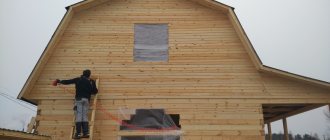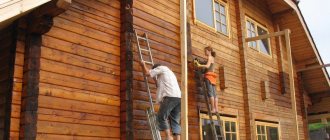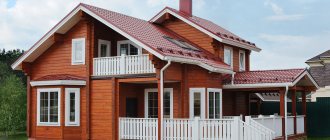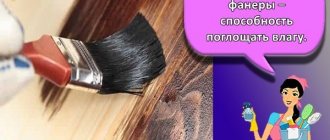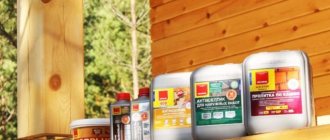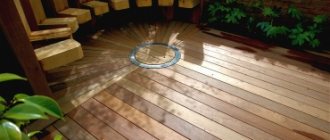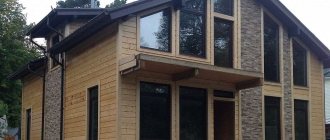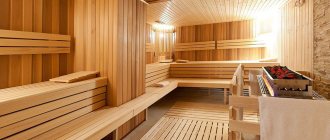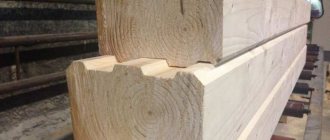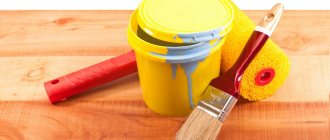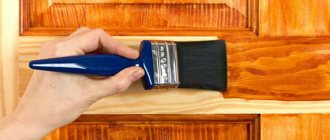Environmental friendliness in the construction of private cottages is gaining increasing popularity. For this reason, wooden facades are no longer uncommon. Everyone knows that wood has a beautiful texture and is at the same time a very difficult material to use. In this article we will tell you how to preserve the strength of natural wood and protect it from the harmful effects of the external environment. Let's figure out why impregnations are required and what paint is best to paint a wooden house. Let us describe the technology for carrying out measures for processing a wooden facade, taking into account previous operation.
What paint is best to paint a wooden house?
Why protect wooden facades
It doesn’t matter whether the house is clad with construction boards using a curtain wall system or is entirely assembled from timber, the wood used in outdoor decoration requires protection. There are objective reasons for this; any wooden material has the following unattractive properties:
- easy flammability and excellent flammability;
- porosity and, as a result, moisture saturation;
- deformation under the influence of different temperatures;
- exposure to fungus and mold, as well as bugs and pests.
Wood damaged by mold requires treatment
Unprotected wood dries out over time, loses its attractive texture and color (turns gray), becomes loose, and therefore not durable. That is why the wood on the facade should be protected from the following factors:
- effects of UV rays;
- high humidity;
- insect pests.
In order to enhance the natural excellent characteristics of wood, and at the same time reduce risk factors for unpleasant situations, wood is impregnated with special compounds and treated with paints and varnishes.
Painted wall of a wooden house
Impregnations
Primer solutions or impregnations can be used as a preparation material for painting, or can also be used as a finishing material. There are 3 types of primers:
- antibacterial (from fungus and mold);
- flame retardants (from fire);
- water-repellent.
Since it is difficult to give preference to only one method of protection, fire-bioprotection compositions have been developed that include 2 mechanisms. Water-repellent primers generally protect against UV rays and strengthen wood.
On a note! All primers have a short lifespan as a topcoat. Therefore, without further painting, facade treatment will have to be carried out regularly every 2-3 years.
Primer treatment is a simple and mandatory process when processing a wooden facade.
Impregnation treatment will not only improve the appearance, but also increase the service life of the wood. For facade work, you should choose deep penetration compositions on an organic basis. Such solutions are usually toxic and have a characteristic unpleasant odor. When working with them, PPE (personal protective equipment) is used: gloves, goggles, respirator.
On a note! Most primers have a transparent base, which means that treatment with this composition will preserve the natural grain and color of the wood.
Prices for glaze impregnation for wood
Glaze impregnation for wood
Rubber
Manufactured using latex. It has many similarities with the previous version and even surpasses it in some ways. This material has ultra-high strength, is absolutely environmentally friendly, and has excellent vapor permeability, which makes it almost ideal for wood. However, the unjustified high cost of rubber paints slightly spoils the overall picture.
Facade paints
Any paintwork material used for facade work must have a certain set of qualities. But in the situation with wood, this list increases, due to the natural vulnerability of the tree.
Characteristics that any façade material should have:
- resistance to precipitation of various temperatures;
- resistance to temperature changes;
- coating color stability;
- abrasion resistance;
- resistance to mechanical and physical influences;
- chemical inertness.
Facade paints can be successfully combined: wood protection and an interesting design solution
When it comes to painting a wooden facade, the paint requirements are supplemented by the following criteria:
- Plastic. Wood is a breathable, flexible material. Logs and boards can change volume depending on temperature and changes in humidity levels. Therefore, the decorative coating material must also be elastic and not crack.
- Vapor permeability. Decorative material should not create a barrier for moisture to escape from the body of the wall in order to prevent the onset of rotting.
- Fire safety. The material itself must not only protect the wood from burning, but also be non-flammable.
Most wood paints have a rich color palette
On a note! When choosing paint for painting a wooden facade, you should pay attention to the antistatic properties of the material. A paint coating with a high index will accumulate less dust and fine dirt, which means the façade will be much easier to maintain.
Prices for various types of paint for wooden facades
Paint for wooden facades
Classification of coatings for facades
Essentially, when choosing a paint, you select the type of future surface that will be obtained after applying the material to the wood. For exterior use, all paints are classified according to the type of solvent, the resulting texture and quality of gloss.
Gloss
Matte or shiny surface is not only beauty. Glossy coatings are more durable because they contain more resins. Matte surfaces are usually obtained from breathable decorative compounds. In addition, the glossy finish is more resistant to moisture and less susceptible to abrasion.
Manufacturers indicate the gloss level of the final coating on the can with a number ranging from 0 to 100. It is customary to divide the gloss level into 6 main groups.
Variety of colors for wooden facades
Table 1. Gloss levels.
| Digit range | Reflectivity |
| from 0 to 5 | matte without reflection effect |
| from 5 to 10 | matte with low reflection |
| from 10 to 30 | semi-matte have some shine |
| from 30 to 60 | semi-gloss with medium gloss level |
| from 60 to 90 | glossy with shine effect |
| from 90 to 100 | super shiny |
Solvent
All types of paints are diluted with 3 types of solvent:
- water, the compositions are called water-dispersed;
- organic chemistry, such as white spirit, acetone, solvent;
- inorganic compounds.
White Spirit
Paints diluted with inorganic compounds are rarely used in everyday life. For wooden facades, materials are usually used that are diluted to the desired consistency with water, as well as enamels, varnishes, alkyd and oil paints. The specificity of organic solvents is their unpleasant odor.
On a note! Water-dispersed materials can only be applied at positive temperatures. Paints diluted with organic compounds can be used even with a slight minus.
Texture
Facade paints come in textured (volumetric) and forming materials for smooth surfaces. Textured compositions are not used for wood processing, since wood initially has a rich texture and does not require additional decoration. Smooth compositions can be transparent, such as varnishes, or dense, like enamel.
Even covering with colored paint allows you to preserve the natural texture of the wood.
Do-it-yourself painting of OSB boards inside the house
Before painting OSB indoors, you need to understand the intricacies of the work and the positive aspects of this solution. Painting is an option that can be implemented quickly, and you will not need to spend much money. You can also talk about the following advantages of coloring:
- A variety of types of paint and varnish products and color options, which makes it easy to choose a shade that suits the interior of the room;
- The ease of the process, you do not need to have special skills and knowledge, this saves money on the services of professionals;
- Ease of repairing damage; if damage occurs, individual areas can be repainted;
- Possibility of repainting, when the finish gets boring, the coating can always be updated by changing the color;
- Improving the protective properties of the surface; there are paints and varnishes that have moisture-proof characteristics and also create a protective layer against ultraviolet radiation;
- The surface can be cleaned; many types can be washed.
Painting OSB boards indoors is a way to hide the textured coating characteristic of the material. Although some property owners prefer to highlight the texture by only changing the shade, then varnish or stain is used.
Painting is also carried out on special types of wallpaper. Before painting the wallpaper and gluing it to OSB, the surface is prepared.
Painting OSB boards indoors is a way to hide the textured coating characteristic of the material.
Why do this, features
When deciding how to paint OSB inside the house, we must not forget about the wood component of the material. This makes it possible to use a larger number of coloring agents produced for wood.
However, this material has a number of features that people pay attention to when choosing:
- Poor indicator of surface adhesion, not all paints can adhere well to such a surface, the presence of special binding agents in the constituent elements prevents paints from penetrating deep into the enamel;
- The textured structure of the material, the surface may seem smooth, but in fact it contains roughness and irregularities. Therefore, preparatory work is mandatory; sanding is indispensable; such a texture requires increased paint consumption;
- The service life of the panels, the longer the panel is used without treatment, the more difficult it will be to paint, and the more difficult it will be for the dye to adhere to it. In this regard, it is better not to put off painting the panels inside the house for too long.
All these features require special attention when choosing the paint to be used. Therefore, the different options, their features and the properties obtained as a result will be described below.
Types of paints
Before you start painting the wood, you should decide what quality of façade you plan to get in the end. Modern paints and varnishes make it possible to process wood and at the same time obtain surfaces of different appearance:
- natural in color and texture, with varying degrees of gloss;
- matte with a hint of color, but maintaining texture;
- opaque and glossy.
Facade painting
Let's consider the most popular compositions, their positive qualities and some disadvantages.
Oily
The most famous compositions and the most affordable. The material completely covers the natural color, creating a dense film on the surface. It is this layer that perfectly protects the wood from moisture; the coating has almost zero absorption of any solutions. Oil paints are produced on the basis of drying oil.
This paint has a very short service life, quickly fades and begins to crack under the influence of temperature. The downside of hydrophobicity is the lack of vapor permeability, that is, the layer does not allow moisture to pass through, but also does not allow the tree to breathe, which can lead to rot within the wood mass.
Oil-based paint has a very short lifespan
Among other things, such compositions take a very long time to dry, about 10 -12 hours. They are more suitable for routine repairs of low buildings, fences or sheds, as they require regular updating.
Alkyd
Compositions formed on the basis of resins with the addition of oils. The PF marking is more understandable to a wide range of people. The composition does not penetrate inside to a sufficient depth, forming a durable film on the surface. They dry faster than oil-based compounds, but have a very unpleasant odor. They form a hydrophobic durable layer that is not subject to fading from moisture and temperature. It is this combination of qualities that makes alkyd paint very popular for treating wooden facades in regions with high humidity.
Glossy facade treated with alkyd paint
The paint loses color when exposed to direct sunlight, and over time the surface loses its gloss. If it happens that the paint was applied to damp wood, the layer will begin to bubble.
Silicone
Compositions based on organic compounds or resins. They have proven themselves well in operating conditions in humid climates. Silicone (or latex) paint coating is durable even after applying one layer. The surface has a high degree of chemical inertness; the facade can be washed with almost any means. The paint does not fade in the sun and does not fade. In addition, the coating is resistant to mechanical stress and abrasion. The main drawback is the very high price.
Matte surface of a wooden facade painted with silicone paint
In a special article we will talk in detail about the advantages of silicone paint for facades, and also consider painting technology.
Prices for popular brands of waterproof silicone paint
Waterproof silicone paint
Acrylic
Popular paints for finishing wooden facades. There are acrylic paints on sale on a water dispersion basis, that is, they are diluted with water and compositions based on an organic solvent. They have excellent adhesion, form a vapor-permeable layer that is resistant to moisture and ultraviolet radiation. That is, the coating does not fade, the color is not washed out by rain, and the wood breathes. The paint does not have an unpleasant odor and dries quickly. The protective layer is abrasion resistant and has a long service life.
On a note! Acrylic compounds are commercially available that allow repair work to be carried out even at low temperatures.
Paint can enhance the natural color of wood, making the material more durable.
Aqueous dispersions
Such paints can be silicone, silicate and acrylic; what they have in common is that they are all diluted to the desired consistency with clean water. Depending on the main substance, the price of the product can vary greatly. The advantages of such compositions include:
- absolute environmental cleanliness,
- vapor permeability of the layer,
- rich color palette,
- inertness to chemicals,
- long service life.
The paint dries very quickly and is very easy to apply.
Water-based paints have many advantages and are easy to work with.
Some shortcomings are still present. The water in the dye penetrates into the wood, so some surface mobility is expected. Before applying paint, the facade should be treated with a water-repellent primer.
Acrylic
This type of paint has absorbed the whole range of advantages: fast drying (no more than 8 hours), special wear resistance, insensitivity to climatic and atmospheric influences, good elasticity, which prevents the formation of cracks after painting, and lack of odor.
The unique properties of this material include vapor permeability, which allows the wood to “breathe”, that is, not to prevent excess moisture from leaving the room through the wooden walls, thus creating an excellent microclimate inside. Acrylic paint is almost an ideal option for wooden buildings.
How to paint a wooden facade yourself
If there is a need to paint the facade of an already used house, it is quite possible to do this work yourself. To do this, you need to take care of having free time, you will need a lot of it. Purchase consumables in advance: primer and paint in the required volume, coloring pigment (color) and solvent as needed. The approximate consumption rates of the compositions and the service life of the coating are in the table below.
Table 2. Composition consumption rates and coating service life
| Type of paintwork | Consumption (g/m²) | Service life (years) |
| Silicone | 150 — 200 | 20 or more |
| Alkyd | 100 — 120 | 20 |
| Acrylic | 130 — 200 | 15-20 |
| Oily | 100 | 2-3 |
| Water-dispersed | 110 — 130 | 20 or more |
Scaffolding is very convenient for working at heights
In order to put the facade in order, in addition to materials, you will need the following tools:
- stepladder or scaffolding,
- different brush widths,
- rags
- Angle grinder (grinder) with discs for grinding,
- putty knife,
- construction mixer with an attachment for mixing paint.
Depending on the type of paint used, you will need various personal protective equipment: gloves, a respirator, goggles.
Video - An example of incorrect painting of a wooden facade
The main stages of preparing a wooden structure for painting
The technology for painting the outside of a wooden house includes several stages. If you want the paint to lay smoothly and beautifully, so that the coating turns out to be of high quality and durable, you must strictly adhere to the technology and consistently carry out all the preparatory work.
- First, the logs are polished with a grinder using a coarse abrasive with a grain size of P 60-80. Small cracks, nicks and other defects that remain on the wood after sawing are removed from the surface.
- Next, the surface is polished. A fine-grained nozzle P 120 or regular sandpaper is suitable for this work, with the help of which the wood is brought smooth. As a result, the surface becomes smooth and completely ready for further processing. After sanding, the wood better absorbs impregnations and paints.
- Using a construction hair dryer, the walls of the house are cleaned of wood dust formed during the sanding process.
- If there are resin stains on the wood, they are removed with a solvent.
- If there are small cracks and knots that were not removed by sanding, these places are puttied with a special wood putty.
- All metal parts (screws, nail heads) are coated with a special primer for metal.
- Next, the surface is treated with a water- or oil-based antiseptic primer to protect the wood from the adverse effects of atmospheric and biological factors. After the primer has completely dried, begin painting the house.
Technology
The whole process takes place in 4 stages. At the same time, scrupulousness and attention are required to complete the work. It is important to do everything carefully, without leaving untreated areas.
Stage 1. Removing the old coating. This procedure is performed if there is an old paint coating. It needs to be removed. To do this, you can use spatulas, a wire brush, sandpaper or a grinder with an attachment. There will be quite a lot of dust, so you should work with glasses and a respirator.
All work is carried out in dry, not hot weather. The entire area of the facade will have to be protected, including the joints of logs or boards. In order for the work to be completed efficiently and without delay, remove the drainage elements, shutters and trim from the facade in advance. In addition to old paint, dust and street dirt should be removed from the facade.
Important! You should not leave old paint on, even if the layer sits firmly on the surface. Its service life will expire and it will peel off along with the new coating.
Before painting the facade, remove the old coating
Stage 2. After the facade is cleared of paint, the wood is sanded and puttied. If there are areas of darkening, or pockets of fungal infection are visible, the top layer of material should be removed to a clean texture. The rest of the surface is leveled. Existing defects on the surface are eliminated by puttying. Before moving on to the next steps, the putty must dry. The putty material must be compatible in composition with impregnation and paint.
The top layer of wood is cleaned and sanded
Stage 3. Deep penetration impregnation is applied to the cleaned wooden surface, the composition of which is selected depending on the characteristics that require strengthening. Typically, impregnation is applied with a wide brush along the grain to preserve and emphasize the natural texture of the wood.
Do not neglect priming; impregnation will not only improve the quality of the wood, but will increase the adhesion of paint to the surface, while reducing the amount of material consumed. Even though wood primers are quite expensive, their use is worthwhile. Before applying the paint, the impregnation must dry; the period for complete drying is indicated by the manufacturer on the packaging.
For longer service life, the wood should be impregnated with certain compounds.
Step 4. Before starting work, check the long-term weather forecast. Rain is not suitable for painting, nor is heat. In addition, work should be carried out during the daytime, when the dew has either already evaporated or has not yet settled, that is, from 10 to 18 hours. The paint is applied in several layers along the fibers. Each subsequent layer should be applied only after the previous one has dried.
To paint a wooden facade, a wide brush is usually used.
Video - Technology of painting a wooden facade
Some nuances of coloring
It would seem that the process is quite simple and transparent. But here, as everywhere else, there are nuances:
- If the facade has external metal fastening elements, then before priming and painting they should be filled with an oil or acrylic compound to match the color of the wood. This work will be especially relevant if the finishing coating is planned to be made transparent.
- If you approach the issue carefully, you can use several impregnating compounds; water-repellent impregnation is applied last.
- For better surface quality, after the impregnation has dried, the wood should be sanded to remove small roughness and lint.
You can improve the quality of a wooden surface by sanding the wood after applying the primer.
Successful examples and options
Let's consider several good options for painting wood with different compositions.
For a terrace, you need to select paint individually, taking into account as accurately as possible all the features of a particular type of wood. There is no doubt that exposed areas of wood need to be painted darker so that street dirt and dust have less of a negative impact. However, for interior boards such a requirement is not always made, but only for design reasons.
Antique painting does not always mean using a patina effect, but it should use darker and richer tones. The picture clearly shows how they replace the original light wood background.
You can choose red, lilac, yellow or green tones - they will all look equally attractive.
You will see the technology for painting wood in the next video.
Rating of the TOP 15 best paints for wood 2021-2022
| Place | Name | Price |
| TOP 4 best wood paints by price/quality for 2021-2022 | ||
| 1 | Dulux Bindo 2 matte white | Find out the price |
| 2 | Tikkurila Siro Himmea matte white | Find out the price |
| 3 | Dufa Premium Woodflex | Find out the price |
| 4 | FINNCOLOR Oasis Hall&Office washable | Find out the price |
| TOP 4 best wood paints for exterior use | ||
| 1 | VGT VD-AK-1180 Wood façade | Find out the price |
| 2 | Dulux Easy Upgrade - Windows and Doors | Find out the price |
| 3 | Caparol Amphibolin moisture resistant | Find out the price |
| 4 | NEOMID Facade for wood | Find out the price |
| TOP 4 best wood paints for interior work | ||
| 1 | V33 Renovation Perfection for walls and furniture in the kitchen | Find out the price |
| 2 | Lakra MA-15 | Find out the price |
| 3 | Dulux Easy Upgrade - Furniture and Wood | Find out the price |
| 4 | Tikkurila Euro Matt 3 | Find out the price |
| TOP 3 best frost-resistant paints for wood | ||
| 1 | brite Professional | Find out the price |
| 2 | Parade Classic W3 Interior | Find out the price |
| 3 | Alpa Profi 3 | Find out the price |
Manufacturers
When choosing the really best paint for wood, pay attention to its packaging, components, and expiration date. Good manufacturers produce their products in sealed containers, convenient for long-term storage. They also correctly label the product, indicating on the packaging all the information necessary for the consumer.
Among the already established manufacturers of wood painting products:
- Tikkurila is a Finnish brand that specializes in the production of all kinds of finishing materials. Although its products have a fairly high price compared to others, it is fully compensated by quality. Painting wooden lining, ceilings, floors, furniture, windows and doors with materials from this manufacturer will give them an excellent appearance and protection from environmental influences;
- Alpina - products are manufactured in Germany, have an attractive price and good quality. The manufacturer produces materials for both exterior finishing of wooden buildings and interior work. The advantage is a wide color palette;
- Neomid is a domestic manufacturer that can easily compete with foreign companies. Neomid produces interior paint for wood with increased fire-resistant properties;
- Belinka is a medium-priced, high-quality product from Slovenia. It has a wide range of finishing materials for wood, including protection against fungus, moisture, sun, and chemicals. This product is easy to work with, as it has an optimal texture and does not spread on the surface.
Now you know that when choosing what paint to paint a wooden house inside or outside, you need to pay attention to the main characteristics and positive properties of the available range and purchase what is best suited for your case and budget. However, remember that good and correctly selected finishing materials will help keep the treated surface intact and neat for a long time and will allow you to make repairs much less frequently.
For lovers of natural compositions, we recommend that you get acquainted with such a material as paint with wax for walls. This may be what you need. You may also be interested in learning how to paint the steps of a wooden staircase.
Main features of wood enamel
Enamels are used not only to color wood, but also to create a wear-resistant coating that is indifferent to water drops and jets, and to dirt particles. The color variety of current coloring compositions is very large - every buyer will find exactly the shade that he needs.
Among all brands of enamels, those that can be used not only for wood, but also for concrete, plastic and metal deserve special attention - such versatility can help save money.
And one more useful note: the price in this segment, as a rule, really reflects the level of quality. That is, more expensive enamel will certainly have better hiding power (hiding power means the ability of the composition, when applied equally to the surface, to hide its original color).
